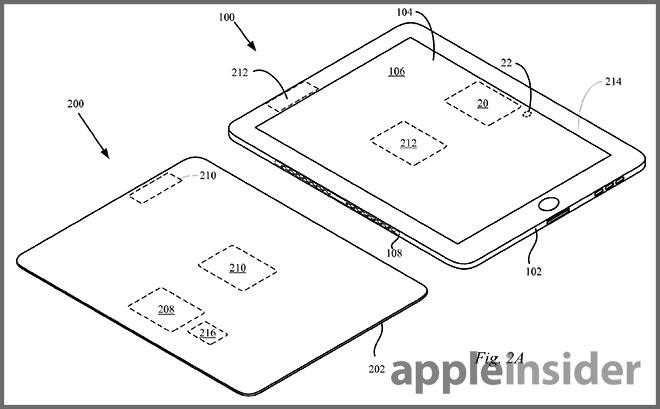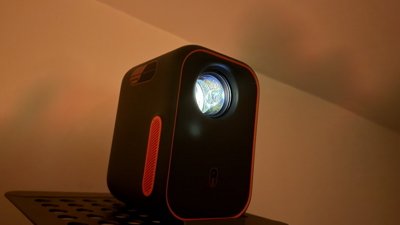An Apple patent application discovered on Thursday reveals that the company is actively investigating wireless charging for its line of portable devices, but proposes to use the technology in a slightly different way than existing solutions.
Wireless charging, also known as inductive charging, has been available on the consumer market for years, promising to replace power cables with a single charging station. Despite attempts from major manufacturers such as Palm and Google, the technology has yet to implemented effectively and is far from ubiquitous.
At first blush, Apple's invention, aptly titled "Integrated inductive charging in protective cover," appears to simply be a first-party incarnation of upcoming products that use inductive charging to transfer power to an iOS device. These components usually incorporate an induction coil and transformer that outputs power via a cord plugged into the device's dock connector. Apple's patent filing describes something different.
Instead of sourcing power from a stationary dock, Apple's invention calls for a tablet case, or more specifically an iPad Smart Cover, to hold the inductive power transmitter. In some embodiments, an internal battery is disposed within the case, basically creating an "on-the-go" wireless charger.
Top-down view of one patent embodiment showing embedded power transmitters (210) and magnets.From the patent's summary:
In the described embodiments, the body portion includes an inductive power transmitter arranged to wirelessly pass power to a corresponding inductive power receiver unit disposed within the tablet device by inductively coupling, at least a first magnetic element, and at least a second magnetic element used to secure the body portion to the display in a closed configuration.
The cover has the usual magnetic attachments and embedded Hall Effect sensor that auto-wakes and sleeps an iPad, but instead of the usual layered padding, the segmented body contains battery cells and necessary wireless charging circuitry.
In order to facilitate efficient power transfer, the primary induction transmitter and corresponding receiver in the iPad would be placed as close together as possible. The patent makes use of the Smart Cover's existing magnet tech, which leverages the unique properties of specialized magnets to "automatically" align the cover with the iPad's display. A property previously covered by AppleInsider describes how the installation of magnets, arranged according to a pattern of alternating polarities, within the Smart Cover's hinge mechanism and iPad body makes it virtually impossible to misalign the two assemblies.
From the patent's description:
In some embodiments, the inductive circuit elements can be located in a peripheral region of the flap and corresponding peripheral regions of the tablet device (such as beneath the display mask that borders an active portion of the display). In this way, power can be inductively transmitted between the flap and tablet device in any number of ways and using any number of configurations of inductive power transfer circuits.
Charging occurs when the flap is covering the display, thus signaling that the device is not in use. Other embodiments describe methods in which the iPad can determine its own battery state and enable the inductive charging circuit when in "portable mode," or not plugged into a power source.
Apple's system is not completely wireless, however, as the cover itself needs to be charged. This is accomplished through a normal AC adapter, though the patent does note that solar cells can be disposed in the outer layers of the cover to harvest ambient energy.
Illustration showing inductive transmitter positioning in various modes.It should be noted that current iPads do not contain the inductive charging circuitry required by the patent, possibly hinting that such integrated components are being studied for a future model of the tablet.
While it is unclear if future Smart Covers will incorporate the wireless charging technology described above, recent rumors claim Apple is working to release such features in an iteration of the iPhone as early as this year.
The company has already shown interest in inductive charging, most recently filing for a patent in November covering near-field magnetic resonance as it applies to a desktop computer setting.
Apple's inductive charging cover patent was first filed for in September 2011 and credits Justin Richard Wodrich and Stephen Robert McClure as its inventors.
 Mikey Campbell
Mikey Campbell








-m.jpg)






 Wesley Hilliard
Wesley Hilliard
 Malcolm Owen
Malcolm Owen
 Andrew Orr
Andrew Orr
 William Gallagher
William Gallagher
 Sponsored Content
Sponsored Content
 Christine McKee
Christine McKee

 Thomas Sibilly
Thomas Sibilly







16 Comments
Now you would have to plug your smart cover to the power outlet instead of having to plug the iPad itself, what's the point apart of putting 'wireless charging' in the feature list. Pointless
I agree, this is a bit weird. Surely a better idea would be that the smart cover acts as a receiver for power from another base unit. The base unit would be plugged in all the time, maybe with a sensor so that it only switches on when the ipad is placed on it. The smart cover could send the juice to the ipad through connectors built into the smart magnet areas. That way, they wouldn't have to build the big inductor into the ipad, keeping the size and weight down.
[quote name="Scapal" url="/t/156465/apple-proposes-on-the-go-wireless-charging-via-ipad-smart-cover-with-built-in-battery#post_2293073"]Now you would have to plug your smart cover to the power outlet instead of having to plug the iPad itself, what's the point apart of putting 'wireless charging' in the feature list. Pointless[/quote] Keep in mind that the vast majority of patents never become products - and I agree that the value of this one is quite limited.
[quote name="test123" url="/t/156465/apple-proposes-on-the-go-wireless-charging-via-ipad-smart-cover-with-built-in-battery#post_2293081"]I agree, this is a bit weird. Surely a better idea would be that the smart cover acts as a receiver for power from another base unit. The base unit would be plugged in all the time, maybe with a sensor so that it only switches on when the ipad is placed on it. The smart cover could send the juice to the ipad through connectors built into the smart magnet areas. That way, they wouldn't have to build the big inductor into the ipad, keeping the size and weight down.[/quote] I love your idea.
solar panel Inductive charger!...